Emergency Bumble Bee Nest Relocation!
go.ncsu.edu/readext?935599
en Español / em Português
El inglés es el idioma de control de esta página. En la medida en que haya algún conflicto entre la traducción al inglés y la traducción, el inglés prevalece.
Al hacer clic en el enlace de traducción se activa un servicio de traducción gratuito para convertir la página al español. Al igual que con cualquier traducción por Internet, la conversión no es sensible al contexto y puede que no traduzca el texto en su significado original. NC State Extension no garantiza la exactitud del texto traducido. Por favor, tenga en cuenta que algunas aplicaciones y/o servicios pueden no funcionar como se espera cuando se traducen.
Português
Inglês é o idioma de controle desta página. Na medida que haja algum conflito entre o texto original em Inglês e a tradução, o Inglês prevalece.
Ao clicar no link de tradução, um serviço gratuito de tradução será ativado para converter a página para o Português. Como em qualquer tradução pela internet, a conversão não é sensivel ao contexto e pode não ocorrer a tradução para o significado orginal. O serviço de Extensão da Carolina do Norte (NC State Extension) não garante a exatidão do texto traduzido. Por favor, observe que algumas funções ou serviços podem não funcionar como esperado após a tradução.
English
English is the controlling language of this page. To the extent there is any conflict between the English text and the translation, English controls.
Clicking on the translation link activates a free translation service to convert the page to Spanish. As with any Internet translation, the conversion is not context-sensitive and may not translate the text to its original meaning. NC State Extension does not guarantee the accuracy of the translated text. Please note that some applications and/or services may not function as expected when translated.
Collapse ▲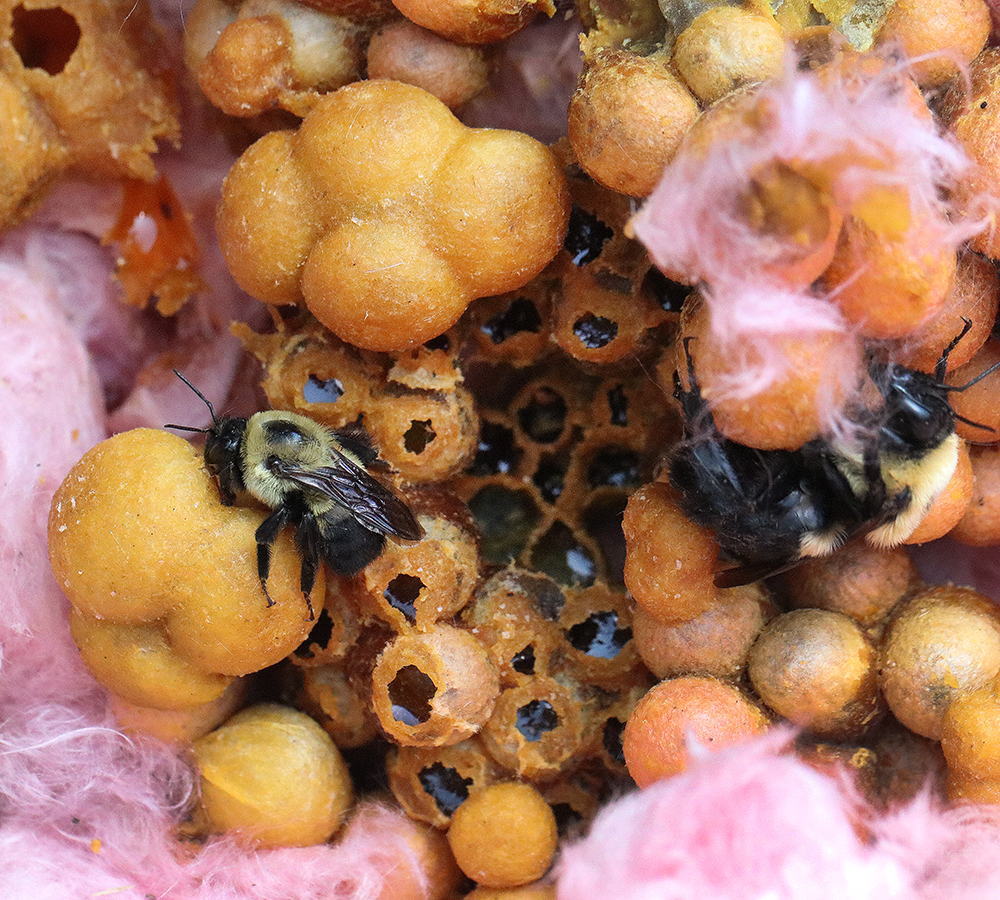
Close up of bumble bee nest at Buck Naked Farm. Photo by Debbie Roos.
Last weekend I got a text from Jennifer Howard, beekeeper and cut flower grower at Buck Naked Farm in Moncure. They were having well issues on the farm and while troubleshooting the problem had discovered a bumble bee nest in the well house. The plumber was on the way so Jennifer asked me for advice on relocating the nest so he could work inside the small space and not worry about getting stung. Moving a bumble bee nest is not easy and should only be done as a last resort; success is not guaranteed but in this case it was the only shot at saving these bees!
Bumble Bee Life Cycle
Bumble bee queens hibernate through the winter and when they emerge in early spring will first seek out spring flowers so they can feed on nectar to gain energy. Next they get busy choosing a nesting site. Bumble bees nest in cavities and can find all kinds of imaginative spots to build their nests: abandoned underground rodent burrows, brush piles, watering cans, bluebird houses, at the base of grasses, dryer hoses…wherever they can find a little sheltered cavity and some nesting material. Bumble bees can also be imaginative in their choice of nesting material – I have seen one nest constructed of goat hair and dried grasses! The nest at Buck Naked Farm was made in a pile of insulation.
The bumble bee queen works solo in the beginning to build the nest. She has to raise all the worker bees that will help her! She produces wax flakes that she uses to construct little wax cups that are filled with nectar from the flowers she has been foraging on. She makes more wax cups that she fills with pollen and then lays eggs on these (they are called brood cells). When the eggs hatch the larvae feed on the pollen. The queen continues bringing back pollen and nectar until the first new bees emerge, which will all be females. These new female worker bees will now take over foraging duties while the queen focuses on building more brood cells and laying eggs. If the bees are able to find adequate flowers to forage on, the nest builds in size over the summer. Bumble bee nests can range from a few dozen bees to a few hundred. In late summer, if the bees have been able to collect enough pollen and nectar from nearby flowers, male bees emerge and a new queen is produced. By fall the old queen has died along with the workers. Only the new queen survives and she will mate and then seek out a sheltered spot to hibernate (under a stone, beneath the leaf layer, in a hole in a log, in the soil, etc.) through the winter.
Tips on Relocating a Bumble Bee Nest
I shared some advice with Jennifer on relocating a bumble bee nest. Below are some general guidelines.
If the nest is not inside an object (flower pot, bird house, etc.) that can be moved, you will need to select a nest box that will be the new home for the bees. The nest box should have a small entrance for the bees to come and go. Line the bottom of the nest box with some soft nesting material (cotton batting, dried grass clippings, etc.).
Make sure you have all the tools and equipment you need before you start the relocation process. You want to get the job done quickly to minimize stress on the bees.
Be prepared for the bees to be defensive, as you are disturbing their home and they have brood to protect. Wear protective clothing, at least a long sleeved shirt and gloves.
Ideally the nest should be moved at night, because bees can’t fly in the dark. If possible, use a flashlight with a red beam (bees can’t see the color red) or cover the flashlight with red plastic so the bees don’t react. Try and recruit a helper to hold the flashlight while you move the nest!
Usually nests are covered so start by carefully uncovering the nest until it is exposed. Gently scoop the nest from underneath using a shovel or whatever tool is appropriate for the situation. A wide shovel is best so you can get the entire nest in one scoop. Be careful not to crush any delicate brood cells or spill nectar from the wax pots! Gently place the nest with the nesting material into the new nest box.
Relocating the Bumble Bee Nest at Buck Naked Farm
I went out to the farm to support Jennifer while she moved the nest. The photos below document the removal process. We have 15 different species of bumble bees in North Carolina; the bees at Buck Naked Farm are brown-belted bumble bees (Bombus griseocollis). Check the photo captions for details.
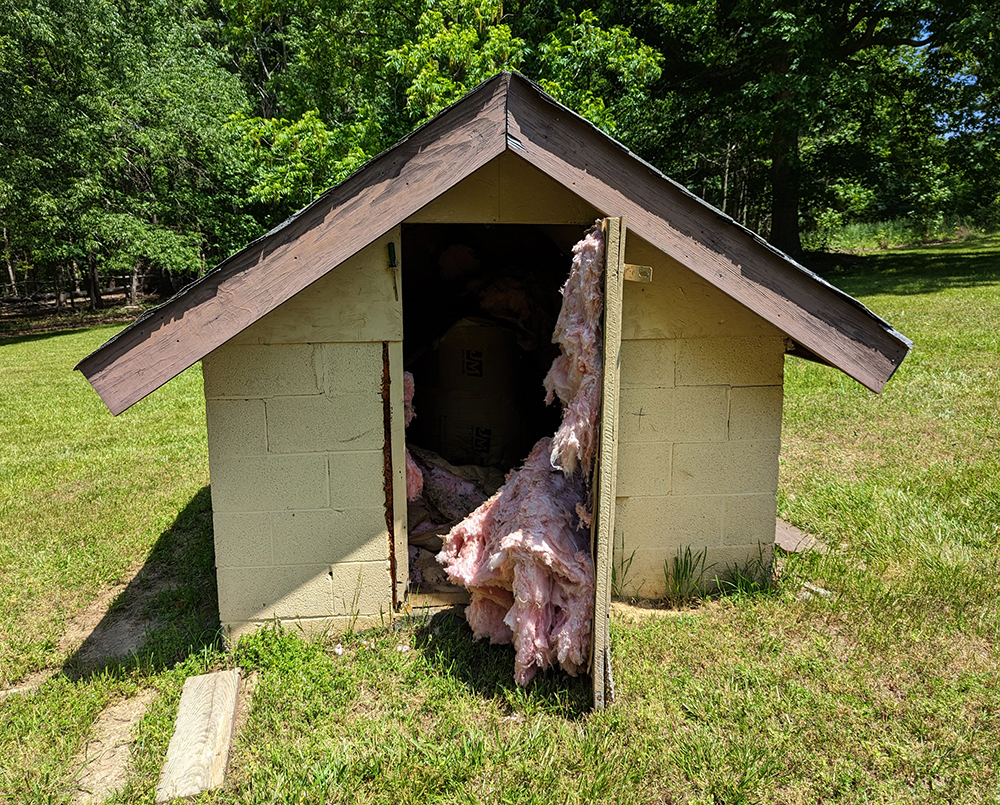
While Jennifer was gathering tools to assist with the move I opened up the door to the well house and saw a pile of pink insulation on the floor just inside the door. The nest was hidden from view under a layer of insulation. Normally nests should be moved at night but Jennifer had to move this nest on short notice so it was done at mid-day (not ideal but unavoidable). Photo by Debbie Roos.
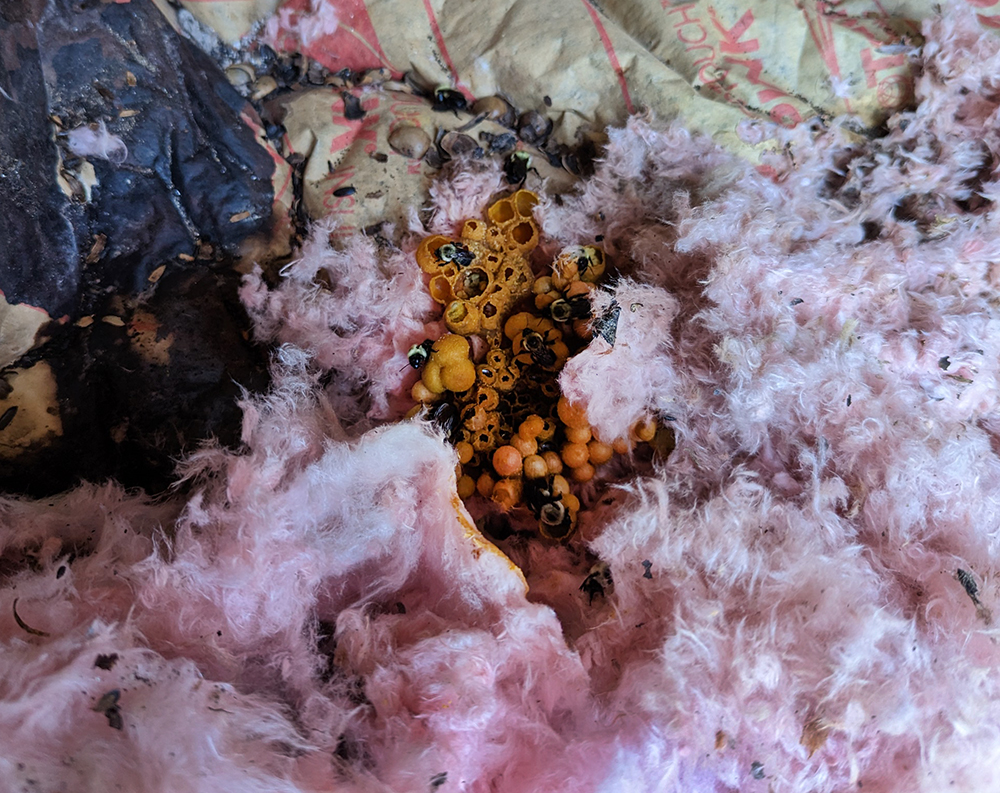
View of the bumble bee nest after removing the top layer of insulation. The nest was on the floor in the well house, immediately in front of the door. Photo by Debbie Roos.

The bumble bees made their nest in insulation. Photo by Debbie Roos.
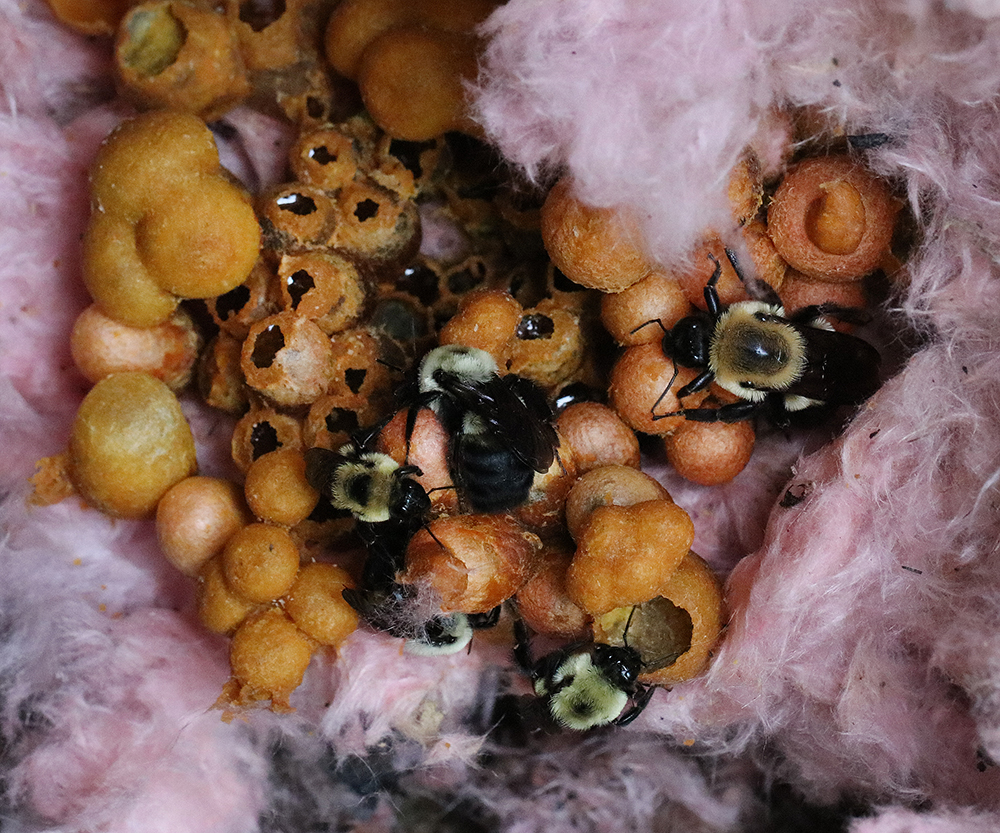
Close up of bumble bee nest showing brood cells and wax pots full of nectar and pollen. These are brown-belted bumble bees (Bombus griseocollis). The queen is at the far right. Photo by Debbie Roos.

Close up of bumble bee nest. Photo by Debbie Roos.

Wax pots full of nectar and pollen. Photo by Debbie Roos.
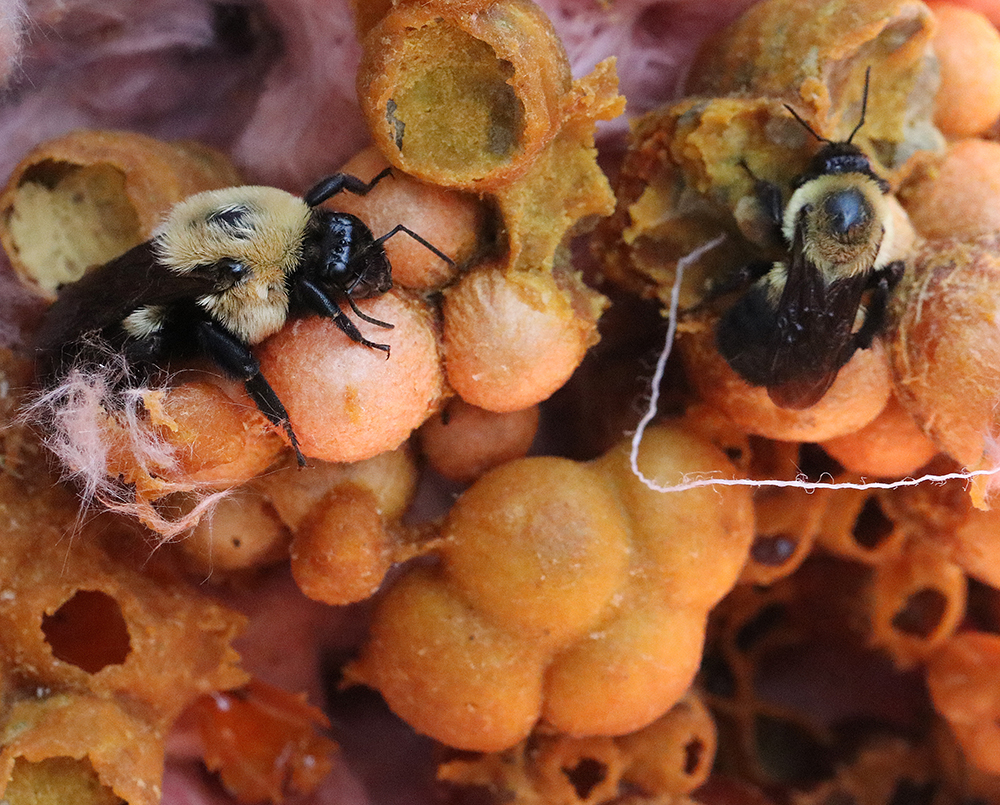
Close up of bumble bee nest. Photo by Debbie Roos.
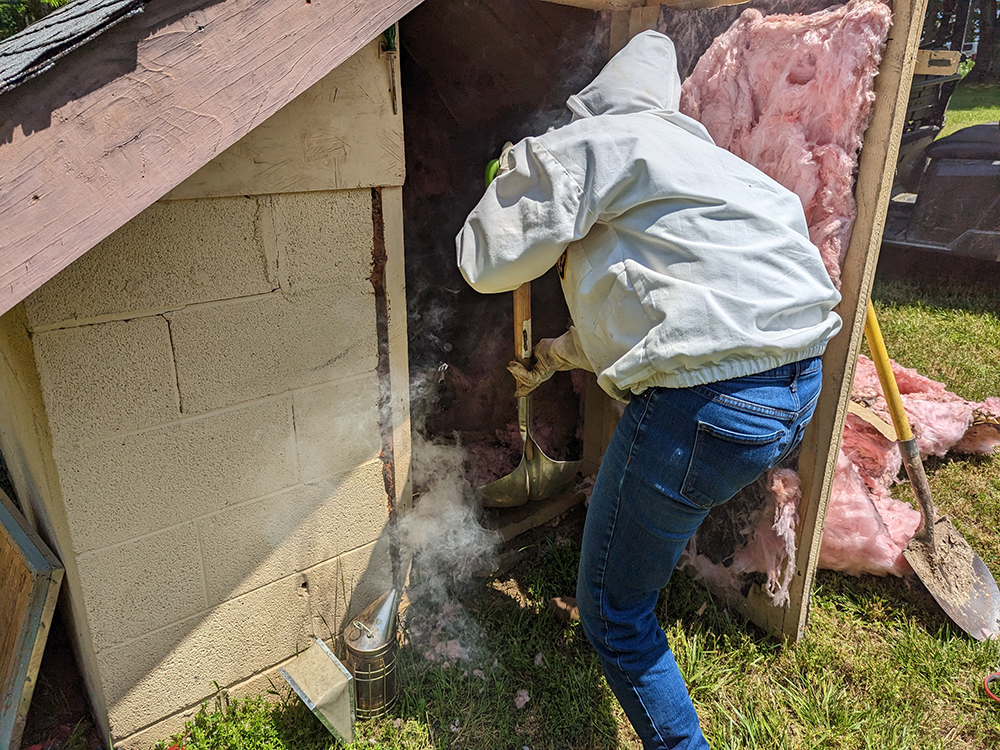
Jennifer used a wide shovel to gently scoop up the nest from below. She wore her beekeeping suit in case the bees were defensive when the nest was moved. To our surprise the bees remained relatively calm throughout the move and the suit was not needed but best to be safe! Brown-belted bumble bees have a reputation for being relatively docile. Jennifer lit her smoker (used for beekeeping) in case it was needed (it wasn’t). Photo by Debbie Roos.

Jennifer takes great care to move slowly and keep the nest upright and intact during the move. Photo by Debbie Roos.
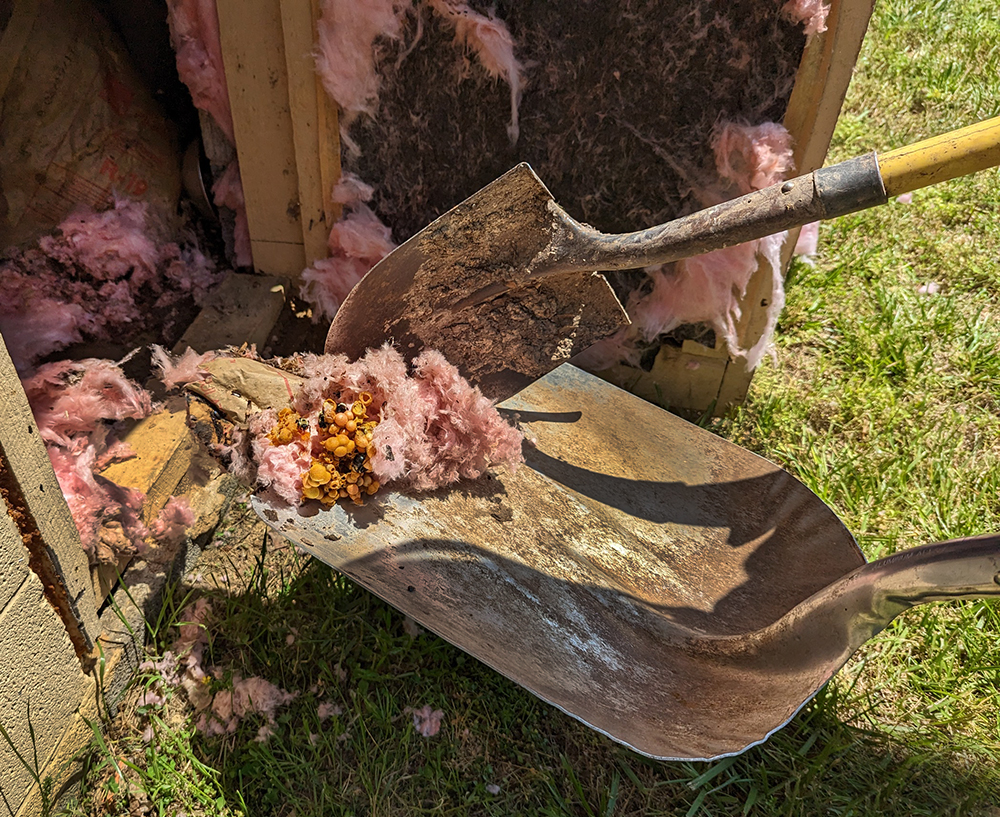
A second shovel helps keep the nest together. Photo by Debbie Roos.

Jennifer is a beekeeper so she placed the nest in an empty honey bee hive body. She first lined the bottom with insulation to provide plenty of nesting material. The nest box was placed right outside the door to the well house and left uncovered for a while to give time for all of the bees to find it after it was moved. Ideally nests are moved at night but Jennifer had to move this nest on short notice because a plumber had to work inside the well house. The nest box was moved to the shade behind the well house once it looked like all of the bees had found their way to the new nest. Photo by Debbie Roos.
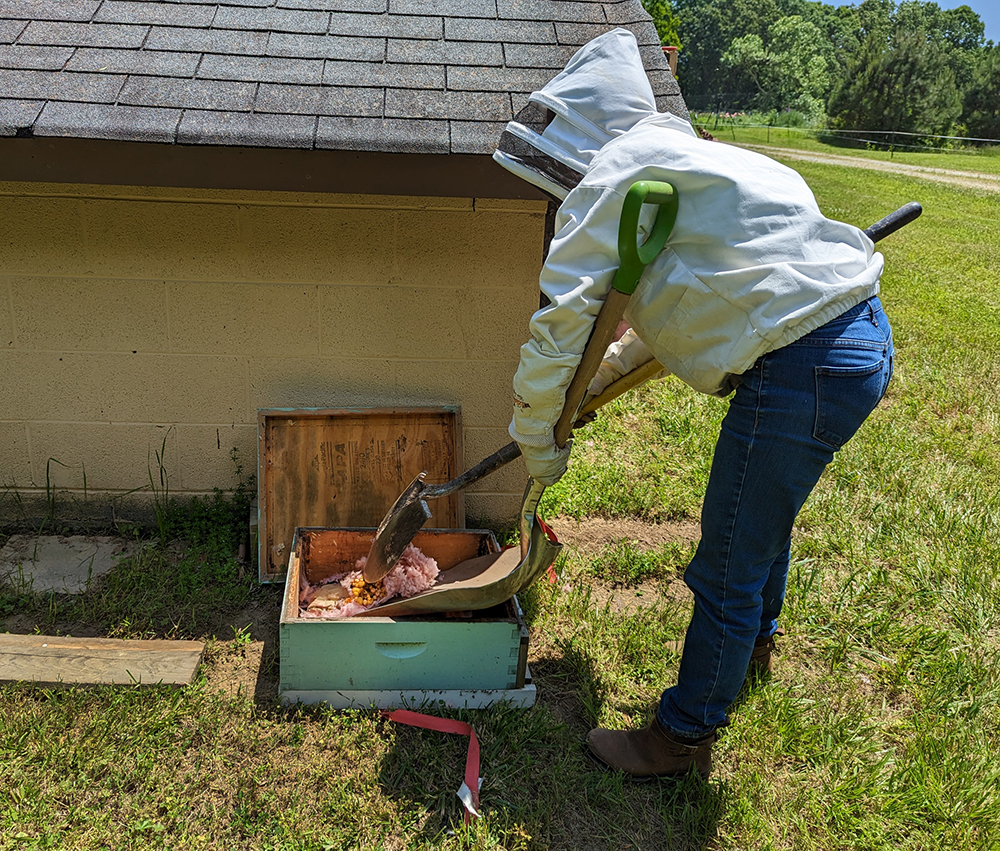
Jennifer transfers the nest to a hive box. Photo by Debbie Roos.
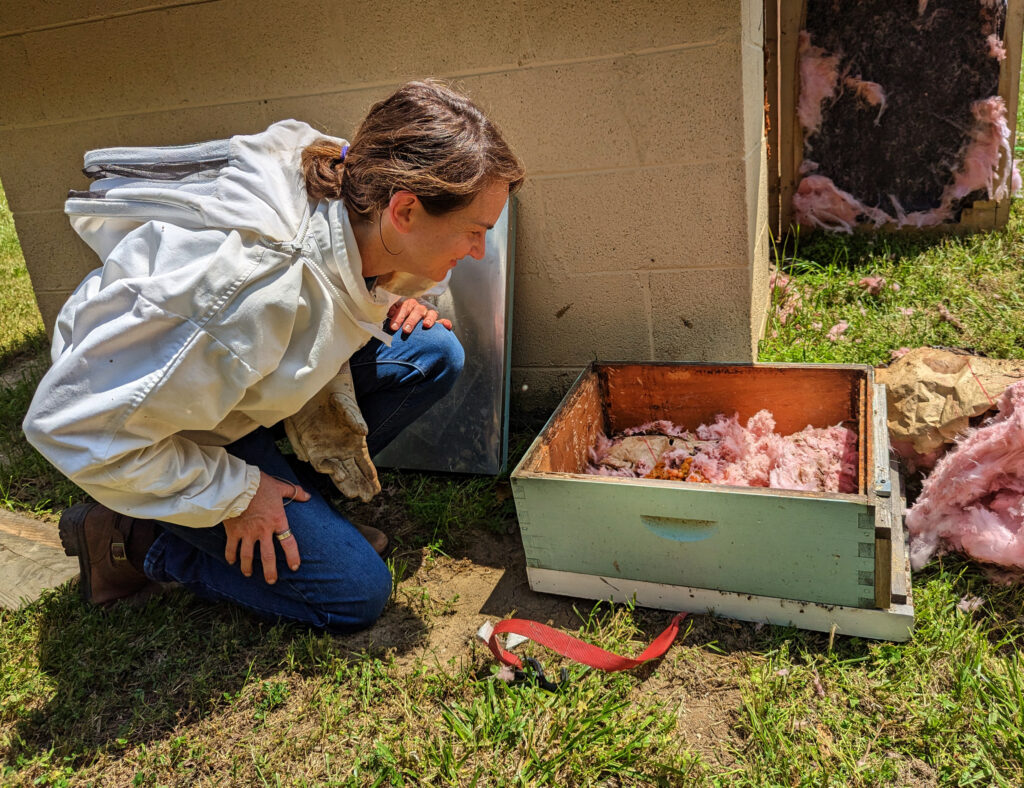
The hive box was placed as close as possible to the old nest entrance to make it easier for the bees to find it. It was only a few feet from the hole the bees used as an entrance to the well house where they had their nest. Jennifer watches to see if bees left in the well house are finding their way into the nest. Photo by Debbie Roos.

Jennifer did such a great job relocating the nest! Photo by Debbie Roos.
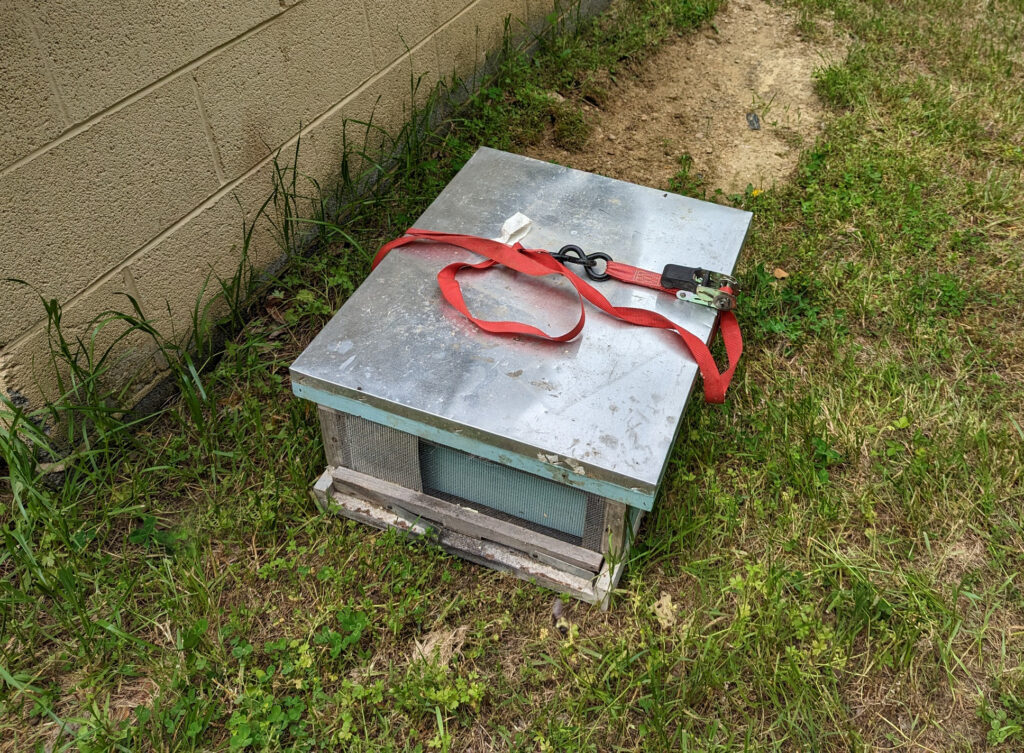
We inspected the nest the next day to make sure it was still active and the bees had resumed normal duties. Photo by Debbie Roos.
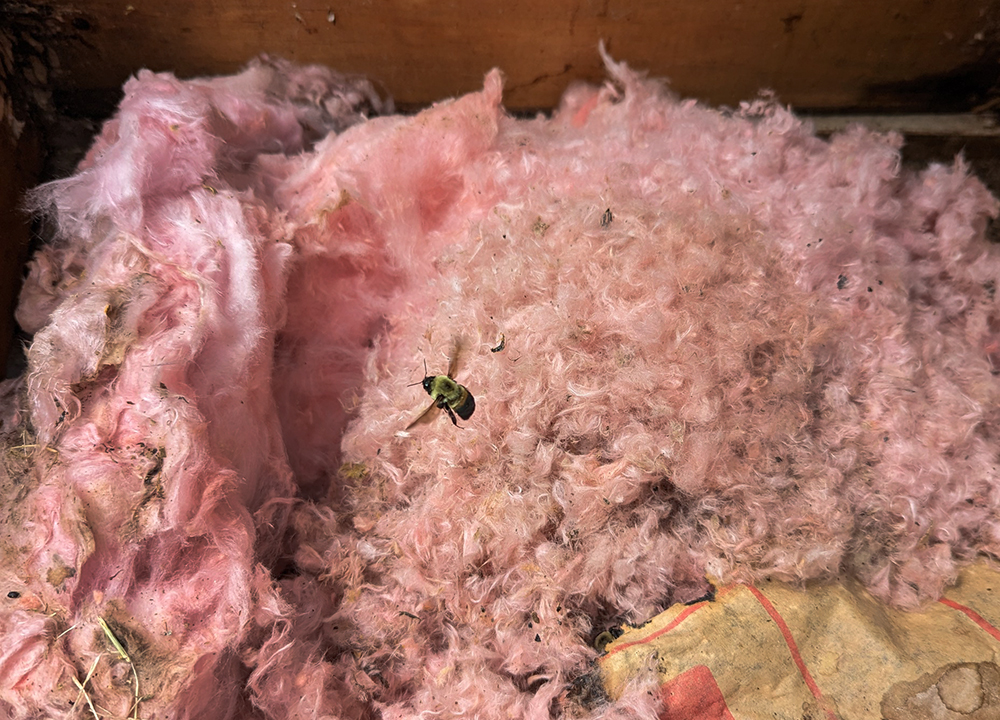
The first thing we noticed when we opened up the hive box was that the bees had covered the nest with insulation. Photo by Debbie Roos.
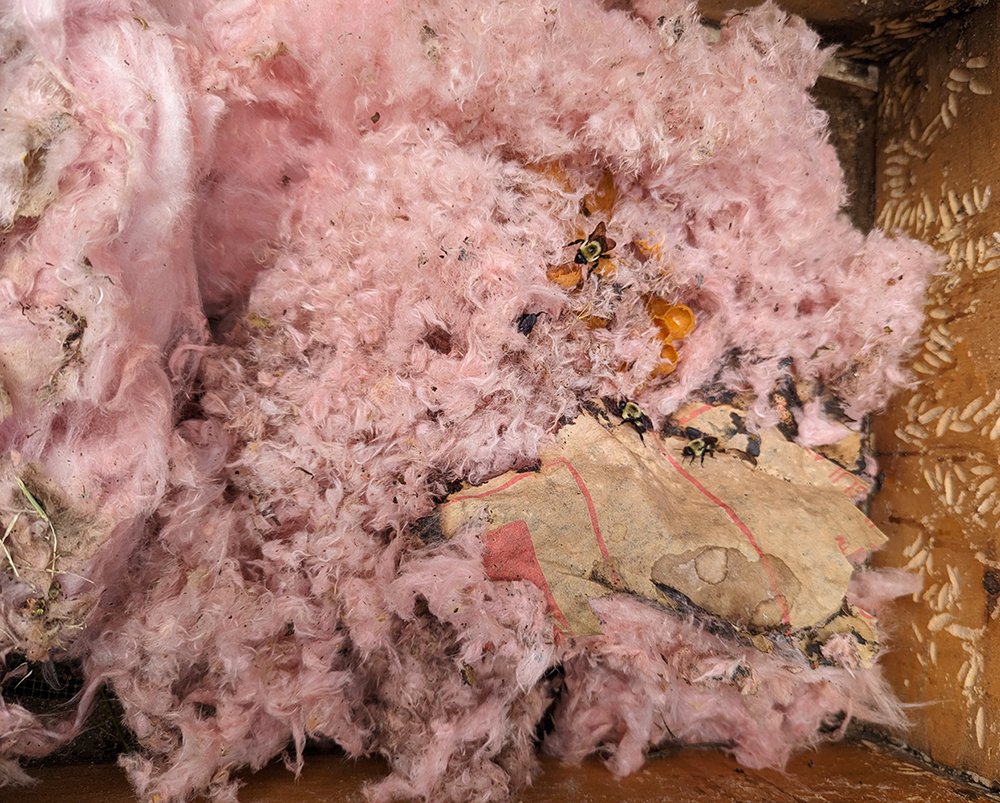
We carefully removed a bit of the insulation just to make sure the queen and workers were present. Photo by Debbie Roos.
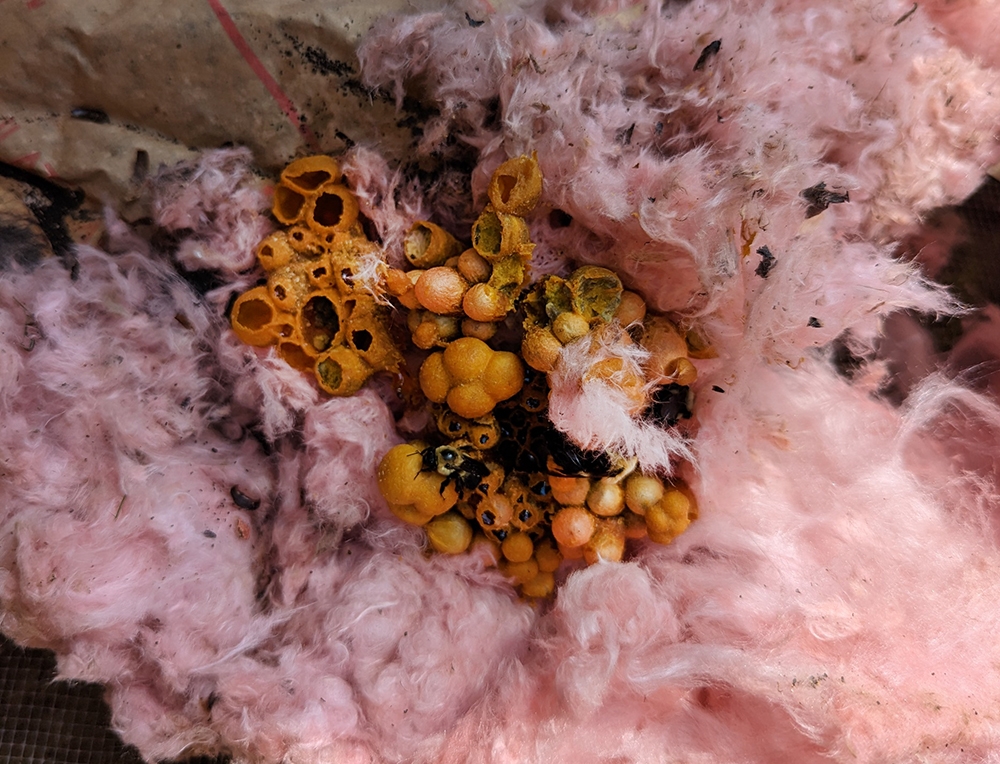
Everything looked good and it looked like the queen and all the workers had found their way into the new nest. Photo by Debbie Roos.

Jennifer and I stood and watched the nest entrance and did a happy dance when we saw multiple bees returning to the nest with pollen! These are brown-belted bumble bees. Photo by Debbie Roos.

Foraging bumble bee returning to the nest with loaded pollen baskets on her hind legs! Photo by Debbie Roos.
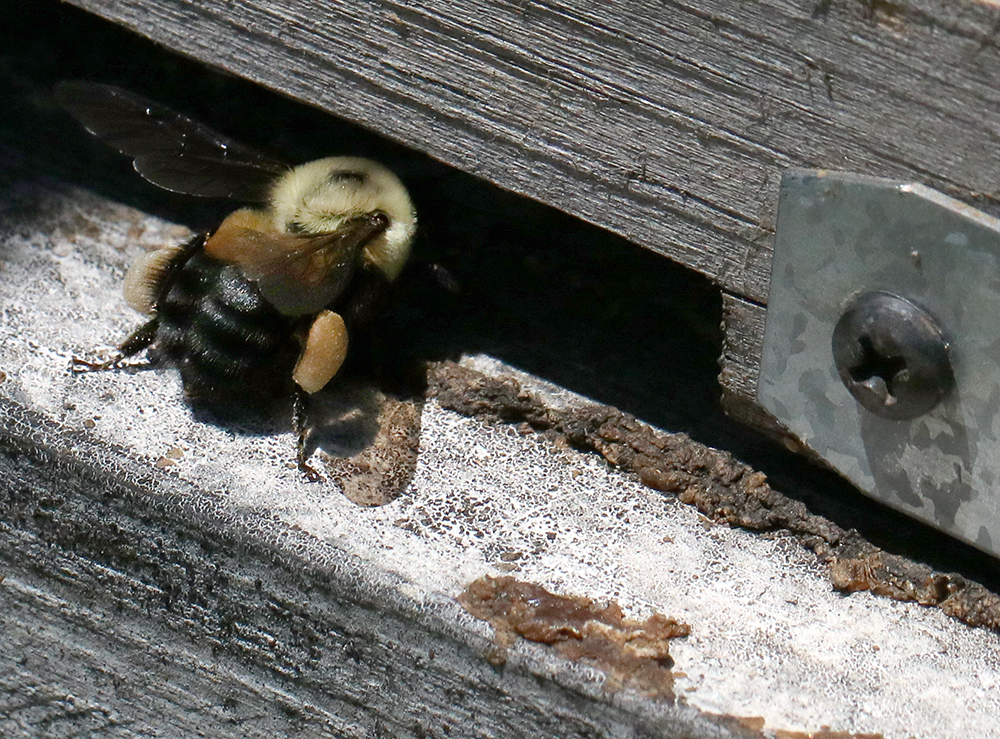
Foraging bumble bee returning to the nest with loaded pollen baskets! Photo by Debbie Roos.
Visit the Buck Naked Farm website to learn more about the farm. Follow Buck Naked Farm on Instagram and Facebook. You can purchase flower Bouquets from Buck Naked Farm at Once in a Blue Moon Bakery & Cafe in Cary!


